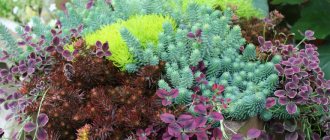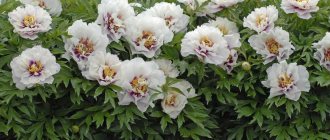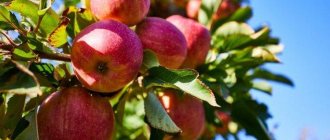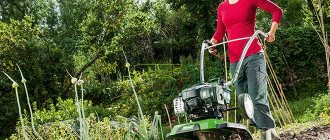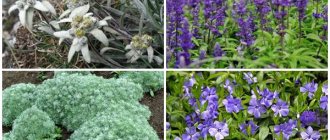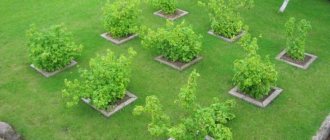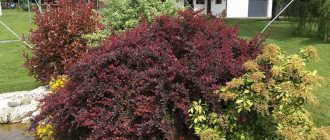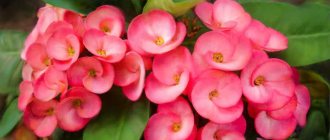Sedum is an unpretentious plant belonging to the Crassulaceae family. Refers to succulents. Sedum is also known as sedum, squeaky, young and hare cabbage.
There are about 500 varieties of flowers, among them low-growing herbaceous plants predominate, and less often shrubs. The most common are perennials. The height of the plant can reach 60 cm.
Description
The leaf blades are thick and dense. They have no petioles. In most cases they are oblong with a serrated edge, but there are other shapes: needle-shaped, round, oval. Their surface can be either smooth or pubescent.
The leaf arrangement can be alternate, opposite or whorled. The color palette of leaves is varied: light green, dark green, yellow, bluish, reddish-violet are found.
The upper leaves are more rounded, the lower ones are pointed and wedge-shaped. The stems are fleshy and strong. Inflorescences located on short shoots are usually umbellate, corymbose or racemose, less often growing singly or in axils.
Sedum flowers are small, star-shaped, and smell pleasant. The colors are yellow, pink, orange, white, crimson, purple. Sedum is a honey plant. The rhizome is shortened, there are many lateral roots.
How does sedum reproduce?
Flower growers and landscape designers highly value sedums not only for their unpretentiousness and versatility, but also for their ease of propagation. Anyone can get a new plant; the main thing is to decide on the method of propagation.
Growing from seeds
Not the most popular way. Quite lengthy and labor-intensive. When growing using this method, you should pay attention to the following nuances:
- Time to plant. Sowing is carried out in autumn or in the first months of spring.
- Selection of capacity. For seedlings, take small bowls or low trays.
- Preparation of soil and seed. It is better to take a ready-made substrate for succulents or prepare your own mixture of sand and peat. The tray is filled 1/3 with soil. The seeds are sown, covered with film and put in a cool place to stratify the seeds for 10-14 days. The soil is regularly moistened, and after a specified period of time the open container is taken to a warm place with a temperature of at least +20 °C. After 2-3 weeks you can observe the emergence of seedlings.
- Caring for seedlings. The resulting seedlings are watered as the soil dries, avoiding overwatering. Plants are kept in a bright place, protected from direct sunlight.
- Dive and transfer. When the seedlings have two true leaves, they are planted in separate containers. As soon as the plants grow well, they are planted in a permanent place. Sedums such as Adolf, intended for indoor home cultivation, are planted in small pots.
Important! When dividing the bush, fresh cuts should be treated with any fungicide or sprinkled with crushed charcoal.
Propagation by stem and leaf cuttings
Sedum is a flower that is quite easy to propagate by cuttings. You can use not only stem fragments as material, but also leaves of any size.
The leaf or stem is air-dried for several hours and then planted in small containers filled with moist succulent substrate. The soil around the plant is well compacted. The cuttings are watered occasionally. After 2-3 weeks you can see how the cuttings begin to grow.
Growing sedum by cuttings
Dividing the bush
The simplest and most common way to propagate a succulent is in the spring. The sedum is dug up, the roots are cleared of soil and divided into several parts containing several young shoots and buds. The plant is dried in air for several hours and planted in a permanent place.
Spreading
Sedum is found in many parts of our planet, but most often grows in the countries of the Northern Hemisphere: Russia, Mongolia, Japan, China, USA, Mexico. Prefers mountainous terrain, tolerates arid climates and temperature changes well, and does not like humidity.
In addition to rocky slopes, sedum settles in pine forests, dry fields, meadows, forest edges, and peat bogs. The plant needs plenty of sunlight.
Possible problems in growing
Like any other plant, sedum can be affected by pests:
- thrips;
- aphids;
- weevils;
- root nematodes;
- sawflies.
To combat them, broad-spectrum insecticides are used.
Most often, sedums are overtaken by fungal diseases. Treatment is carried out using fungicides.
Not only pests and diseases can harm the unpretentious sedum. Often the cause of plant death is simple mistakes in care. They are determined by the following criteria:
- wrinkled leaves indicate the need for additional watering;
- yellowing of leaf blades, rotting of the stem - a sign of excess moisture;
- elongated stems indicate a lack of lighting;
- the shedding of leaves can be the result of drying out soil or sudden changes in air temperature.
Important! Frequent fertilizing with nitrogen fertilizers can have a negative impact on the flowering of sedums.
Plant name
Translated from Latin, the name of the flower means “to pacify” and “to sit.” The first option is due to the fact that the plant has an analgesic effect. The second translation option is due to the fact that the sedum is very low and often grows, spreading over the surface, as if sitting.
The Russian name “sedum” is also associated with its healing effect - people valued it as a cleansing agent.
Use in landscape design
Sedums are popular among lovers of beautiful landscapes. Sedums can act as an independent solo group or as part of a composition. They are widely used for decoration:
- rockeries;
- alpine slides;
- multi-level flower beds;
- lawn boundaries;
- highlighting garden paths;
- fountains and artificial ponds.
They are used to create hanging structures from numerous flowerpots.
Alpine slide using sedums
The variety of sedum varieties is truly amazing. They can be found everywhere, thanks to their unique vitality and ease of reproduction. For many gardeners, collecting these interesting plants becomes an exciting hobby for decades.
Useful properties of sedum
The alkaloids contained in sedum have a sedative and analgesic effect, stop bleeding and lower blood pressure.
The plant contains citric, oxalic, ascorbic and malic acids, which promote hematopoiesis and strengthen the immune system. They normalize metabolic processes and remove toxins from the body.
Flavonoids have a positive effect on the cardiovascular system.
Tannins contained in sedum provide anti-inflammatory and healing effects, and also help in the functioning of the gastrointestinal tract.
Saponins accelerate healing and have a diuretic effect. The plant tones the body, eliminates inflammation, helps in the treatment of bronchitis, ulcers, scurvy, atherosclerosis, skin rashes, fever, anemia, burns and nervous system disorders. Reduces blood cholesterol levels.
Basically, the aerial part of the sedum is used for medicinal purposes - infusions and decoctions are made from it, but sometimes the rhizome of the flower is also used - it is used in the treatment of skin diseases, healing wounds and abrasions. Juice is extracted from the leaves
Diseases and pests: treatment and prevention
| Symptoms | Treatment | Prevention | |
| Sawfly caterpillars | Leaves are pitted | Preparations "Actellik", "Commander", "Iskra" | Regular inspection |
| Thrips | The tops of the stems are twisted | Drugs "Actellik", "Abamectin", "Malathion" | Regular inspection |
| Aphid | Small insects in leaf axils and on flowers | Remove mechanically, treat with soapy tar solution and Biotlin preparation | Regular inspection |
| Nematodes | The roots are affected, the plant withers and dies | There is no treatment. The plant is destroyed along with the soil | Do not flood or overfeed the plant with fertilizers. |
| Fungal diseases | Dark spots on leaves and stems | Cut off and burn the affected areas, treat with Topaz, Prognoz, Chistotsvet, Bordeaux mixture | Proper watering regime, do not overwater |
Sedums are one of the most unpretentious plants for indoor and outdoor cultivation. The wealth of species, varieties and hybrids opens up a wide choice for landscape gardening.
Decorative properties are maintained until stable snow cover. In a number of countries they are used as food.
Varieties of sedum
There are many varieties of sedum, including short, medium and tall. Let's look at photos of the most unusual sedums:
- Sedum Prominent. Plant grows up to 50 cm with pink or purple flowers. The flowering period is in autumn.
- Sedum Iceberg. Its white inflorescences have a diameter of 15 cm.
- Sedum Rubrotinctum. Also known as Red-colored. The length of the shoots is 20-30 cm.
- Sedum Kamchatsky. Distributed in the Far East
- Sedum six-row. Low, has erect shoots from 5 to 15 cm in height.
- Sedum Thickbranched. It has small flat rounded leaves. Forms a hemisphere.
- Sedum Morgana. Sedum with long grayish-greenish hanging vines, at the ends of which there are bright pink or red flowers.
- Sedum Purpureum. Creeping, height about 15 cm.
- Sedum Ruby Glow. The owner of rich, bright flowers and tall stems.
Features of garden care
Sedum is considered an unpretentious plant. But in order for the plant to develop correctly, maintain its decorative qualities and delight in flowering, you must adhere to the basic requirements:
- Lighting. Most varieties of sedum prefer a bright, sunny place, but there are many sedums that grow happily in semi-shady and shady places.
- Temperature conditions. The plant is resistant to summer droughts and frosty winters. However, in damp winters with little snow, it is better to cover sedums with spruce branches or spunbond.
- Watering. Excessive overwatering very often leads to the death of the plant.
- Mulching the soil. Peat, pine bark or fine gravel are used as mulching material. This technique helps retain moisture and minimize the growth of weeds.
- Loosening. Prevents the appearance of weeds, stagnation of moisture, and also helps ensure the saturation of the root system with oxygen.
- Application of fertilizers. For active growth, ready-made preparations for growing succulents with a high nitrogen content are used.
- Transfer. Sedums should be replanted every 5 years in the spring. For rejuvenation, the plant is divided into several bushes and transferred to a new place. Before planting, sand, fine crushed stone and complex mineral fertilizers are added to the soil. Plants are planted at a distance of 15-20 cm from each other
What is the sedum afraid of? All types of sedum do not tolerate excess moisture, wet winters and spring flooding.
Fine gravel, tree bark, peat, pine and spruce cones are used as mulching material for sedums.
